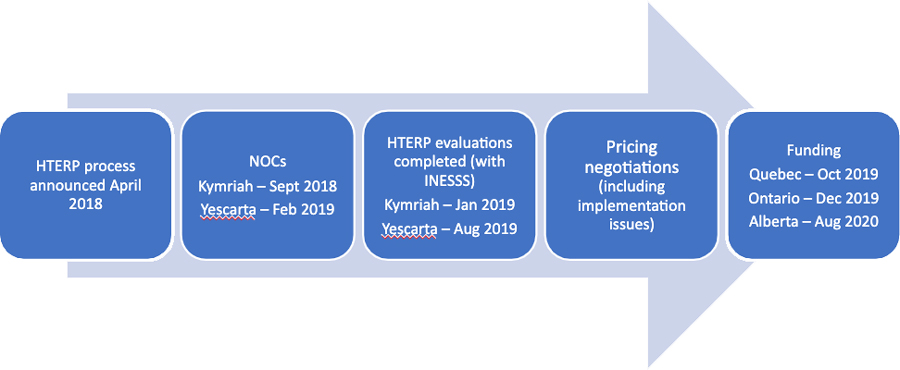Around the Globe
Pathway to Patient Access to CAR-T Therapies in Canada
he first two chimeric antigen receptor T-cell (CAR-T) therapies were approved for the Canadian market in September 2018 (Kymriah) and February 2019 (Yescarta). They represent a unique approach to treatment that challenged Canada’s standard health technology assessment (HTA) and reimbursement pathways. The innovation they represent demanded reciprocal innovation in how these products were evaluated by HTA bodies and managed by payers.
CAR-T Assessment and Reimbursement
Medical device and clinical intervention assessments are led by CADTH’s Health Technology Expert Review Panel (HTERP). For the purposes of the CAR-T reviews, HTERP had its membership supplemented with highly specialized clinical experts as well as policy makers leading implementation of CAR T-cell program planning at the provincial level. The Kymriah review focused on Pediatric Acute Lymphoblastic Leukemia as well as Diffuse Large B-Cell Lymphoma, while the Yescarta review focused on Adult Relapsed or Refractory Large B-cell Lymphoma.
The assessment process included the following components: protocol development; a clinical systematic review; an economic review; review of implementation considerations, ethics, and patient and caregiver perspectives and experiences; and a recommendations report. Stakeholder engagement was a key part of the process and included patient groups and registered clinicians as well as the Canadian Association of Provincial Cancer Agencies (CAPCA), to ensure that any operational and implementation issues were addressed.
- Pediatric Acute Lymphoblastic Leukemia
- Diffuse Large B-Cell Lymphoma
- Relapsed or Refractory Large B-cell Lymphoma
The reviews also identified a number of challenges and opportunities associated with the use of these agents. Key issues cited include:
- Need for clinical expertise in managing adverse effects associated with CAR-Ts,
- Need to collect long-term data to verify the outcomes expected by using these products,
- Need to set up appropriate oversight of treatment sites,
- Need to set up systems and processes to provide access to CAR-Ts for treatment sites,
- Likely need for patient and caregiver travel due to limited treatment sites across the country, and
- Need for clear and transparent patient eligibility criteria to ensure appropriate use and equitable access to CAR-T therapy.
As cited above, one component of the HTERP recommendations was for a price reduction for both CAR-T agents. It is of note that neither Kymriah nor Yescarta went through negotiations via the pan-Canadian Pharmaceutical Alliance (pCPA), according to the pCPA website. It is assumed that negotiations were limited to the first two provinces to provide access (i.e., Quebec and Ontario). Listing agreements for the CAR-Ts are confidential, as they would be for any product; thus, it is not clear if there were any innovative outcomes-based agreements established such as those suggested in other countries.
Finally, a summary of the overall timelines to achieve patient access for these two products is outlined in Figure 1. Compared to the traditional six-month single-agent HTA process via pCODR, the timeline for the HTERP review of these CAR-Ts was approximately four months for Kymriah and six months for Yescarta. The overall timeframe for patient access (i.e., regulatory approval, HTA review, negotiations, and funding) was thirteen months in Quebec and longer in other provinces.

Implementation Case Study
Access to CAR-Ts is controlled via an enrollment process for both clinicians and patients. Clinicians must complete an application process and be eligible to access a CAR-T therapy. For instance, only an oncologist, hematologist, or CAR-T cell specialist licensed to practice in a Canadian province or territory can enrol patients. In addition, the clinician must have confirmation from the CAR-T cell therapy centre that they will treat the patient within a clinically appropriate timeframe.
To be eligible for access to CAR-T treatment, the patient must first have a valid health card from their Canadian province or territory of residence. In addition, they must meet established clinical eligibility criteria. CAR-T therapy is currently funded in Ontario for pediatric and young adult patients with relapsed/refractory B-cell ALL and for relapsed/refractory lymphoma.
A limited number of hospitals are funded to deliver CAR-T cell therapy to serve Ontarians (population 12 million) and patients from other provinces/territories not offering therapy. Designated CAR-T therapy centres include one pediatric centre (Hospital for Sick Children, Toronto) and two adult centres (Juravinski Cancer Centre, Hamilton and Princess Margaret Cancer Centre, Toronto)
Ongoing Research: Ontario CAR-T RWE Initiative
The project is funded under the auspices of the Ontario Institute for Cancer Research-Cancer Care Ontario Health Services Research Network. Evidence generated by this research will be used to make informed decisions regarding the real world impact of this new technology, and to support development of policies and guidelines to ensure the best evidence-based care.
Key Learnings
The first product to be reviewed under this new process is Luxturna (voretigene neparvovec) which is a gene therapy indicated for inherited retinal dystrophy. The submission is nearing the end of the HTA review process, with a draft recommendation expected in late September 2020.
Conclusions
What we have yet to optimize is how all these pillars (i.e., HTA, implementation, and RWE) can be integrated to optimize both access to and the value of CAR-Ts to patients, clinicians, and payers alike. Given the significant future CAR-T pipeline, it is critical for Canada to develop a framework that simultaneously enables access to these products while addressing relevant clinical and economic uncertainties.

